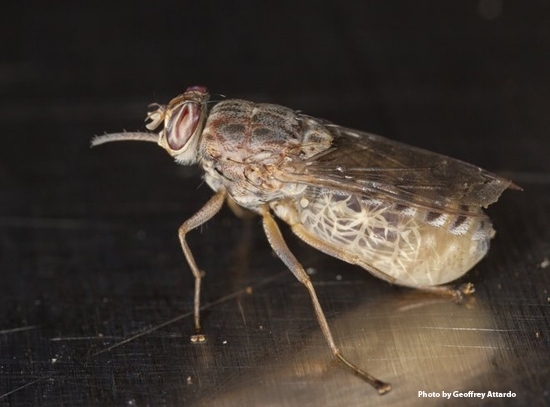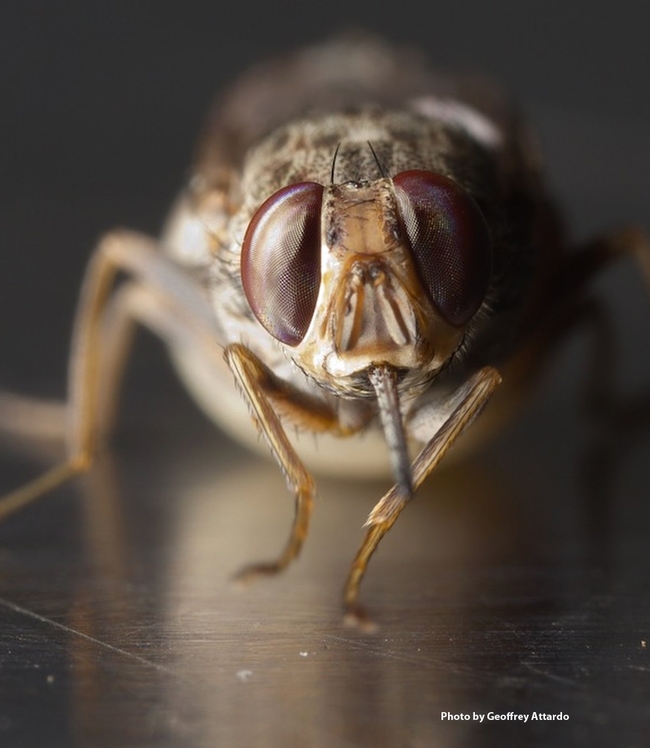
Totally fascinating.
Tsetse fly expert Geoffrey Attardo, a medical entomologist and assistant professor with the UC Davis Department of Entomology and Nematology, drew the attention of Pulitzer-Prize winning science writer Natalie Angier who penned the article, "Everywhere in the Animal Kingdom, Followers of the Milky Way" (subhead: "As scientists learn more about milk's evolution and compositional variations, they are redefining what used to be a signature characteristic of mammals.")
Her lede: "Most female flies take a low-rent approach to parenthood, depositing scores of seed-sized eggs in the trash or on pet scat to hatch, leaving the larvae to fend for themselves."
"Not so the female tsetse fly. She gestates her young internally, one at a time, and gives birth to them live. When each extravagantly pampered offspring pulls free of her uterus after nine days, fly mother and child are pretty much the same size."
Then she quoted the UC Davis medical entomologist:
“It's the equivalent of giving birth to an 18-year-old,” said Geoffrey Attardo, an entomologist who studies tsetse flies at the University of California, Davis.
Attardo focuses his research on numerous aspects of the physiology of tsetse fly reproduction, with the goal to identify and understand key aspects of its reproductive biology. He joined the UC Davis Department of Entomology and Nematology in 2017 from tje Yale University School of Public Health, New Haven, Conn., where he researched tsetse flies in the lab of Serap Aksoy.
In terms of "fascinating physiological adaptations," Attardo considers the tsetse fly "one of the champions of the insect world!" As he explained to us in a 2017 news story: "In addition to being vectors of a deadly disease, Trypanosomiasis, these flies have undergone amazing alterations to their physiology relative to other insects. Some examples of this are their ability feed exclusively on blood, their obligate relationship with a bacterial symbiont, the fact that they lactate and that they give birth to fully developed larval offspring."
"The opportunity to study the adaptations these flies have made is like opening a toy chest for an insect physiologist. My work in tsetse has focused on the molecular biology underlying the adaptations associated with the development of lactation, symbiosis, male and female mating interactions/physiology and nutrient metabolism and mobilization.”
Attardo's published research is drawing national and international attention, as are his incredible images of tsetse flies. He won the 2010 Fogarty Grantee Photo Contest with an image of a tsetse fly. The Yale School of Public Health magazine featured his images on “An Eye for the Tsetse Fly.” The Los Angeles Times published his remarkable video (in 2014) of a tsetse fly giving birth. Also, see his portraits of the tsetse fly on Live Science, published in 2014.
In her New York Times article, Angier points out that "Only in the class Mammalia do all member species nurse their young, yet evolutionary biologists now believe that the roots of mammalian lactation date back more than 300 million years, a good 100 million years before the first mammals appeared."
Who knew?
And while on the subject of tsetse flies, be sure to read the September 2016 article, "Tsetse Flies Are Strange and Dangerous," by Kevin Fitzgerald in Entomology Today, a publication of the Entomological Society of America. Fitzgerald featured the work of Attardo and posted one of his photos.
Attached Images:

